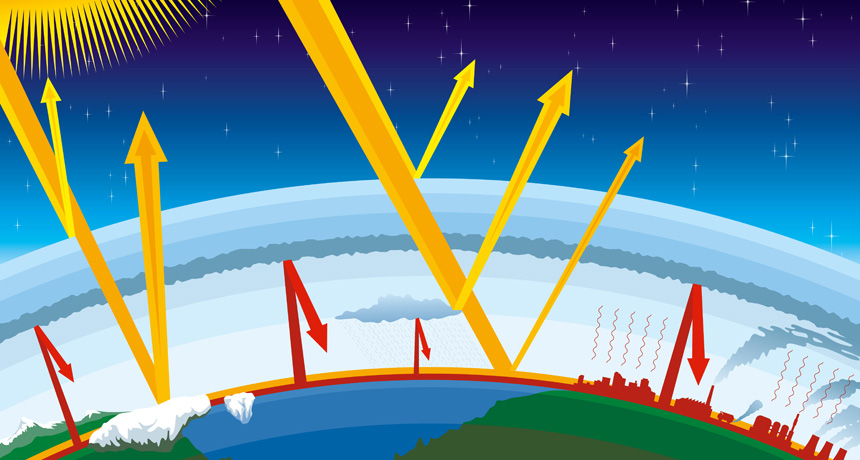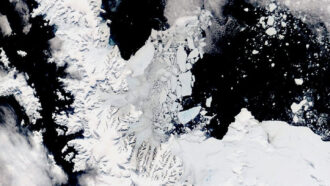Explainer: Global warming and the greenhouse effect
Greenhouse gases trap heat on Earth

Earth’s atmosphere, shown here in light blue, acts like the windows on a glass greenhouse. Some gases in the atmosphere — such as carbon dioxide — will trap certain wavelengths of energy (here shown in red) from bouncing back into space. That trapped energy, or heat, serves to keep our planet warm.
DavidSzabo/istockphoto
Earth’s atmosphere works something like a giant glass greenhouse. As the sun’s rays enter our atmosphere, most continue right down to the planet’s surface. As they hit the soil and surface waters, those rays release much of their energy as heat. Some of the heat then radiates back out into space.
However, certain gases in our atmosphere, such as carbon dioxide, methane and water vapor, work like a blanket to retain much of that heat. This helps to warm our atmosphere. The gases do this by absorbing the heat and radiating it back to Earth’s surface. These gases are nicknamed “greenhouse gases” because of this heat-trapping effect. Without the “greenhouse effect,” Earth would be too cold to support most forms of life.
But there can be too much of a good thing. Carbon dioxide is released when we use fossil fuels. These include coal, oil and natural gas. We burn these fuels, made from the decayed remains of plants and animals, to run electricity-generating plants that power factories, homes and schools. Products of these fossil fuels, such as gasoline and diesel fuel, power most of the engines that drive cars, airplanes and ships.
Scientists have been examining air bubbles in ice cores taken from glaciers. From gases in those bubbles, scientists can calculate what levels of carbon dioxide, or CO2, have been in our atmosphere throughout the last 650,000 years. And CO2 levels have been climbing to where today they are 30 percent greater than 650,000 years ago. That rise in CO2 “is essentially entirely due to the burning of fuels,” Susan Solomon says. She’s a senior scientist with the National Oceanic and Atmospheric Administration, in Boulder, Colo. There, she studies factors that affect climate.
Humans have further increased the levels of greenhouse gases in the air by changing the landscape. Plants take up carbon dioxide to make food in a process called photosynthesis. Once cut down, they can no longer take in CO2. That’s led this gas to begin building up in the air instead of fueling the growth of plants. So by cutting down trees and forests for farmland and other human uses, more CO2 is also added into the air.
“We’ve always had some greenhouse gases in the atmosphere,” Solomon says. “But because we’ve burned a lot of fossil fuels and deforested parts of the planet, we’ve increased the amount of greenhouse gases, and as a result have changed the temperature of the planet.”
Power Words
carbon dioxide A gas produced by all animals when the oxygen they inhale reacts with the carbon-rich foods that they’ve eaten. This colorless, odorless gas also is released when organic matter (including fossil fuels like oil or gas) is burned. Carbon dioxide acts as a greenhouse gas, trapping heat in Earth’s atmosphere. Plants convert carbon dioxide into oxygen during photosynthesis, the process they use to make their own food.
climate The weather conditions prevailing in an area in general or over a long period.
deforest The act of removing most or all of the trees lands that used to hold forests.
fossil fuels Any fuel (such as coal, oil or natural gas) that has developed in the Earth over millions of years from the decayed remains of bacteria, plant or animals.
global warming The gradual increase in the overall temperature of Earth’s atmosphere due to the greenhouse effect. This effect is caused by increased levels of carbon dioxide, chlorofluorocarbons and other gases in the air, many of them released by human activity.
greenhouse effect The warming of Earth’s atmosphere due to the buildup of heat-trapping gases, such as carbon dioxide and methane. Scientists refer to these pollutants as greenhouse gases.
methane A hydrocarbon with the chemical formula CH4 (meaning there are four hydrogen atoms bound to one carbon atom). It’s a natural constituent of what’s known as natural gas. It’s also emitted by decomposing plant material in wetlands and is belched out by cows and other ruminant livestock. From a climate perspective, methane is 20 times more potent than carbon dioxide is in trapping heat in Earth’s atmosphere, making it a very important greenhouse gas.
photosynthesis (verb: photosynthesize)The process by which green plants and some other organisms use sunlight to produce foods from carbon dioxide and water.
radiate (in physics) To emit energy in the form of waves.







